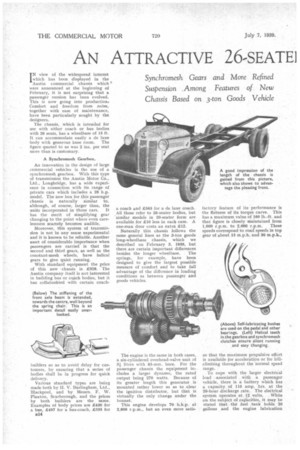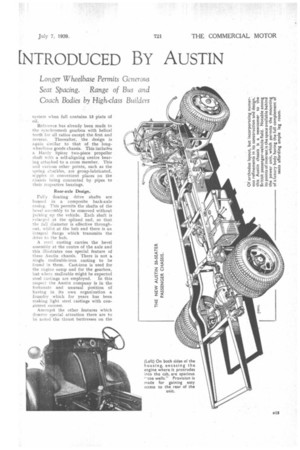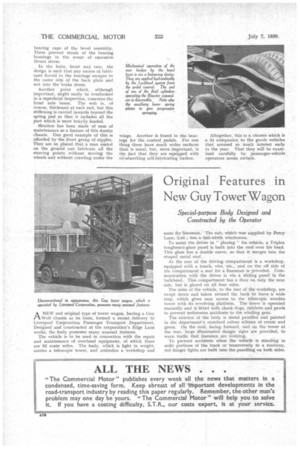AN ATTRACTIVE 26-SEATE] [NTRODUCED BY AUSTIN
Page 48

Page 49

Page 50

If you've noticed an error in this article please click here to report it so we can fix it.
IN view of the widespread interest which has been displayed in the Austin commercial chassis which were announced at the beginning of February, it is not surprising that a passenger version has been evolved. This is now going into production Comfort and freedom from noise, together with ease of maintenance. have been particularly sought by the designers.
The chassis, which is intended for use with either coach or bus bodies with 26 seats, has a wheelbase of 15 ft. It can accommodate easily a de luxe body with generous knee room. The figure quoted to us was 2 ins, per seat more than is customary.
A Synchromesh Gearbox.
An innovation in the design of large commercial vehicles is the use of a synchromesh gearbox. With this type of transmission the Austin Motor Co., Ltd., Longbridge, has a wide experience in connection with its range of private cars which includes a 28 h.p. model. The new box for this passenger chassis is naturally similar to, although, of course, larger than, the units incorporated in those cars. It has the merit of simplifying gear changing to the point where even carelessness scarcely becomes audible.
Moreover, this system of transmission is not in any sense experimental and it is known to be reliable. Another asset of considerable importance when passengers are carried is that the second and third gears, as well as the constant-mesh wheels, have helical gears to give quiet running.
With standard equipment the price of this new chassis is £328. The Austin company itself is not interested in building bus or coach bodies, but it has collaborated with certain coach builders so as to avoid delay for customers, by ensuring that a series of bodies shall be in progress for quick delivery.
Various standard types are being made both by H. V. Burlingham, Ltd., Blackpool, and by Messrs. F. W. Plaxton, Scarborough, and the prices by both builders are the same. Examples of body prices are £430 for a bus, £497 for a bus-coach, £535 for
B14 a coach and £565 for a de luxe coach. All these refer to 26-seater bodies, but similar models in 20-seater form are available for £10 less in each case. A one-man door costs an extra £12.
Naturally this chassis follows the same general lines as the 3-ton goods long-wheelbase chassis, which we described on February 3, 1939. but there are certain important differences besides the longer wheelbase. The springs, for example, have been designed to give the largest possible measure of comfort and to take full advantage of the difference in loading conditions as between passenger and goods vehicles.
The engine is the same in both cases, a six-cylindered overhead-valve unit of 3i litres with 85-mm. bore. For the passenger chassis the equipment includes a larger dynamo, the rated output being 279 watts. Because of its greater length this generator is mounted rather lower so as to clear the ignition distributor, but that is virtually the only change under the bonnet.
This engine develops 70 b.h.p. at 2,800 r.p.m., but an even more satis
factory feature of its performance is the flatness of its torque curve. This has a maximum value of 160 lb.-ft. and that figure is closely maintained from
1,000 r.p.m. to 2,000 r.p.m. These speeds correspond to road speeds in top gear of about 15 m.p.h. and 30 m.p.h.,
so that the maximum propulsive effort is available for acceleration or for hillclimbing throughout the normal speed range.
To cope with the larger electrical load associated with a passenger vehicle, there is a battery which has a capacity of 116 amp. hrs. at the 20-hour discharge rate. The eleetrical system operates at 12 volts. While on the subject of capacities, it may be stated that the fuel tank holds 20 gallons and the engine lubrication system when full contains 13 pints of oil,
Reference has already been made to the synr.hromesh gearbox with helical teeth for all ratios except the first and reverse. Thereafter, the design is again similar to that of the longwheelbase goods chassis. This includes a Hardy Spicer two-piece propeller shaft with a self-aligning centre bearing attached to a cross member. This and various other points, such as the spring shackles, are group-lubricated, n:pples at convenient places on the c.hassis being connected by pipes to their respective bearings.
Rear-axle Design.
Fury floating drive • shafts are housed in a composite hack-axle casing, This permits the shafts of the bevel assembly to be removed without jacking up the vehicle. Each shaft is enlarged at the splined end, so that the full diameter is effective throughout, whilst at the hub end there is an integral flange which transmits the drive to the hub.
A sreel casting carries the bevel assembly at the centre of the axle and this illustrates one special feature of these Austin chassis. There is not a single malleahle-iron casting to be found in them. Cast-iron is used for the engine sump and for the gearbox, but ,s.liere malleable might be expected
steel castings are employed. In this respect the Austin company is in the fortunate and unusual position of having in its own organization a foundry which for years has been making light steel castings with consistent success.
Amongst the other features which deserve special attention there are to be noted the thrust buttresses on the bearing caps of the bevel assembly. These prevent strain of the bearing housings in the event of excessive thrust stress.
In the hubs, front and rear, the design is such that any excess of lubricant forced to the bearings escapes to the outer side of the back plate and not into the brake drum.
Another point which„ although important, might easily be overlooked in a superficial inspection, concerns the front axle beam. The web is, of course, thickened at each end, but this stiffening is carried inwards beyond the spring pad so that it includes all the part which is most heavily loaded.
Mention has been made of ease of maintenance as a feature of this Austin chassis. One good example of this is afforded by the front group of nipples. They are so placed that a man seated on the ground can lubricate all the steering points without moving the wheels and without crawling under the wings. Another is found in the bearings for the control pedals. For one thing these have much wider surfaces than is usual, but, more important, is the fact that they are equipped with oil-absorbing self-lubricating bushes.
Altogether, this is a chassis which is a fit companion to the goods vehicles that aroused so much interest early in the year. That they will be examined carefully by passenger-vehicle operators seems certain.




















































































